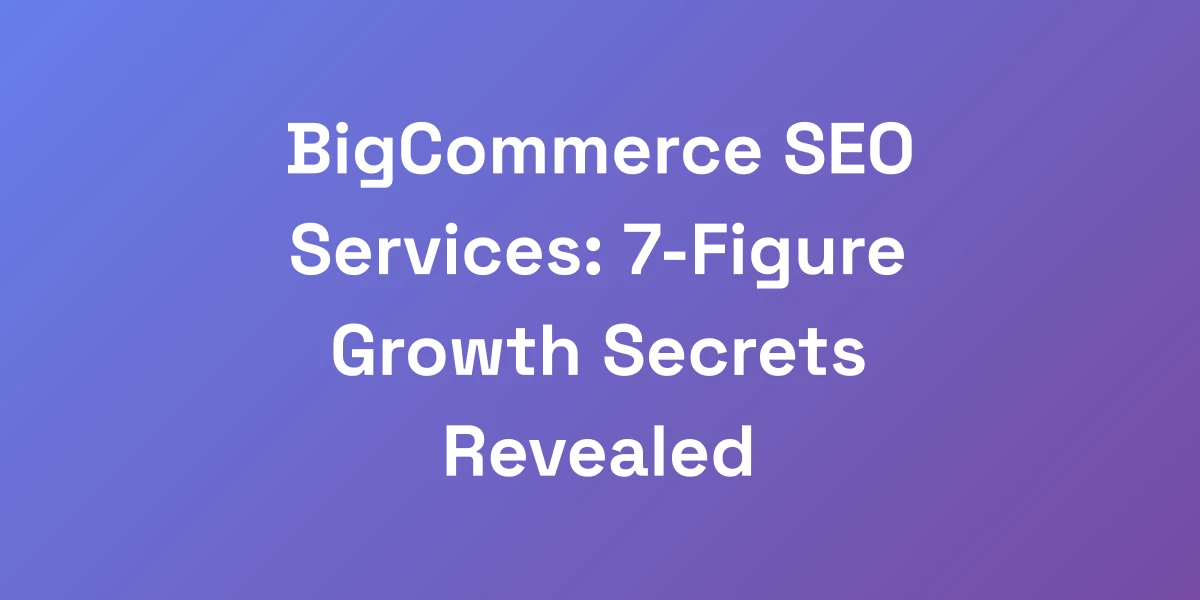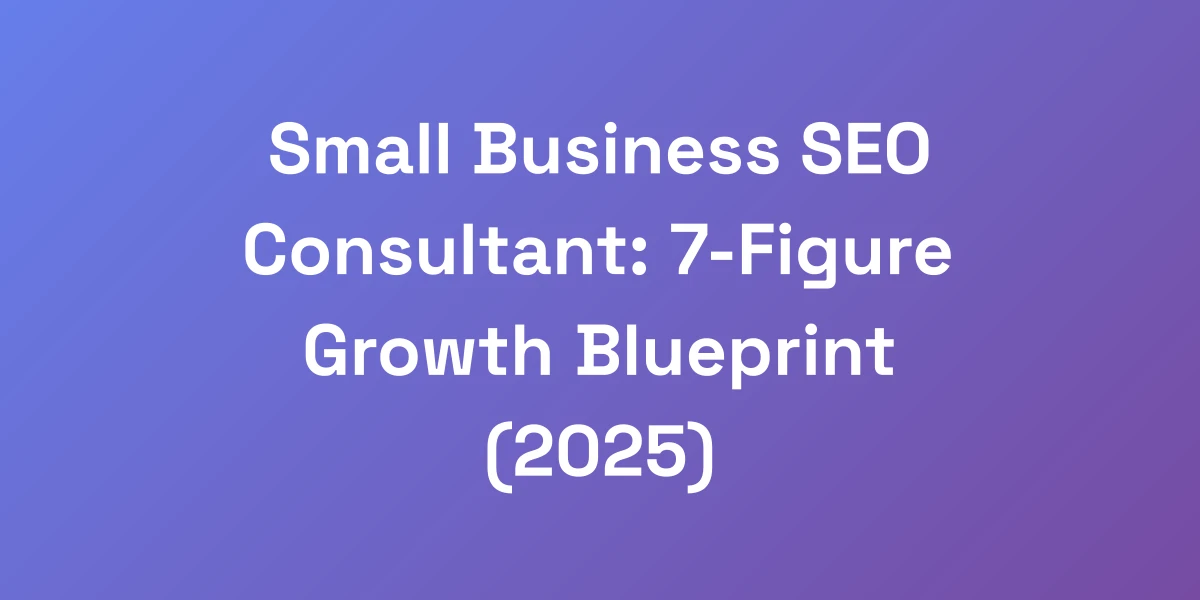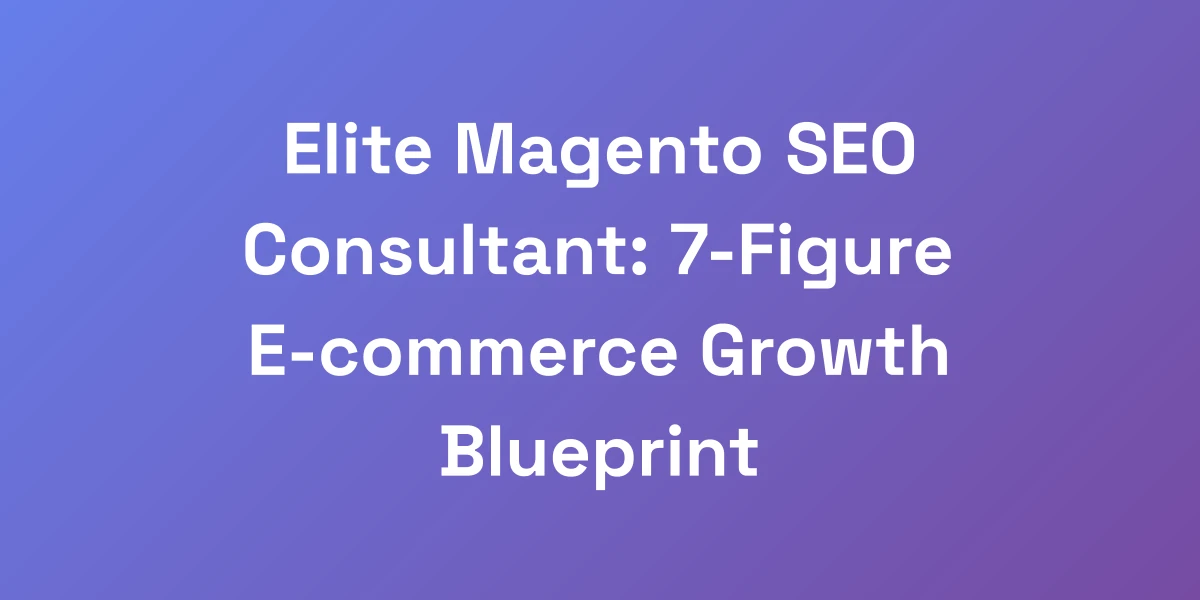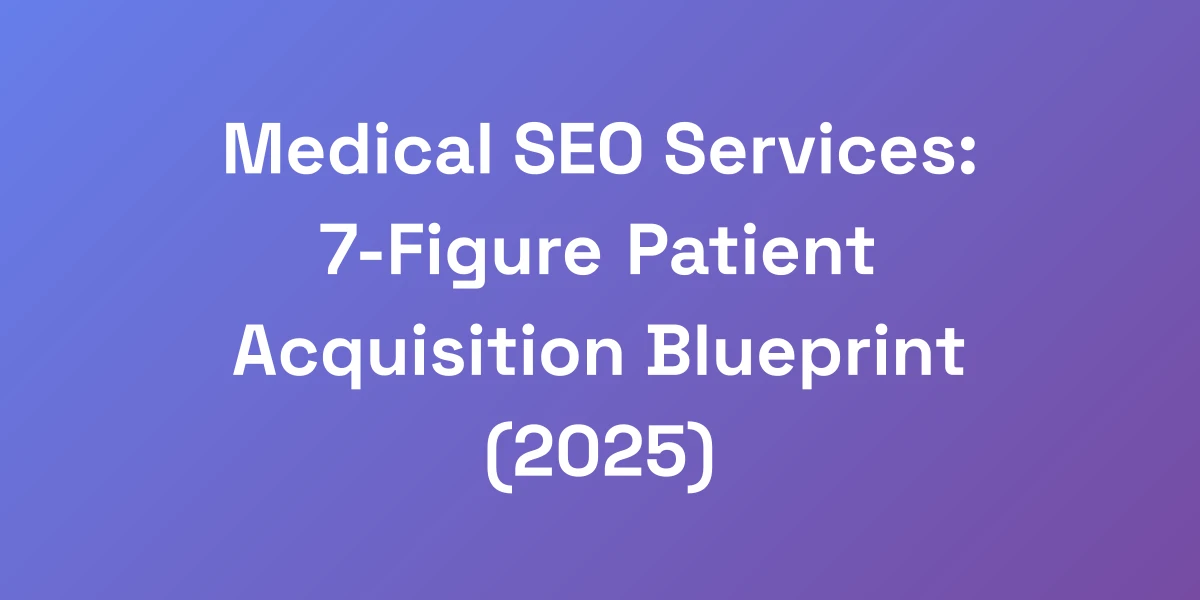
BigCommerce SEO Optimization: 7-Figure Store Success Blueprint
Mar 7, 2025 | By [email protected]
Let’s get real – BigCommerce SEO optimization isn’t just another checkbox on your to-do list. It’s the lifeline of a 7-figure store. Imagine turning your store into a traffic magnet, where every click translates into dollars in your pocket. Sounds like a fantasy? Well, it’s not.
We’ve seen countless BigCommerce stores stumble because they treat SEO as a side project. They miss out on the massive organic traffic that can skyrocket their sales. Why? Because they don’t understand the strategic leverage needed to make BigCommerce’s native SEO tools work like a charm.
Are you ready to ditch the guesswork and dive into the battle-tested blueprint for SEO domination? In this article, we’re breaking down the exact steps to transform your BigCommerce store into a search engine powerhouse. Let’s cut through the noise, tackle the challenges head-on, and build a store that doesn’t just survive, but dominates.
Stay with us – by the end of this guide, you’ll have a clear, actionable roadmap to SEO success, propelling your BigCommerce store into the 7-figure club.
Why Most BigCommerce Stores Fail at SEO (And How to Win)
Let me cut through the BS right now – 95% of BigCommerce store owners are leaving money on the table with weak SEO. We’ve helped scale multiple 7-figure stores, and here’s the truth: BigCommerce’s built-in SEO features are just the beginning. The real money is in leveraging these tools strategically while most of your competitors fumble around with basic optimizations. In this guide, we’re giving you the exact blueprint we use to dominate search rankings and drive massive organic traffic to BigCommerce stores.
Common SEO Mistakes Killing Your Revenue
Most BigCommerce store owners make fundamental errors that cripple their SEO performance. These mistakes aren’t just minor slip-ups; they’re direct hits to your revenue streams.
- Neglecting Keyword Research: Without thorough keyword research, you’re essentially shooting arrows in the dark. Targeting the wrong keywords means missing out on potential customers actively searching for what you offer.
- Ignoring On-Page SEO: From meta descriptions to header tags, overlooking on-page elements can significantly lower your search rankings. Every page should be optimized meticulously.
- Poor URL Structure: Cluttered and non-descriptive URLs confuse both users and search engines. Clean, keyword-rich URLs are a must for better indexing and user experience.
- Duplicate Content: Whether it’s product descriptions or category pages, duplicate content can lead to penalties from search engines, diluting your site’s authority.
- Skipping Mobile Optimization: With over 60% of e-commerce sales happening on mobile, a non-responsive design isn’t just a mistake – it’s a guarantee that you’re losing sales.
These aren’t just hypothetical issues; we’ve seen them firsthand in stores struggling to make a mark online. Avoiding these pitfalls is your first step toward SEO success.
The Real Cost of Poor SEO Implementation
Let’s talk numbers – poor SEO is bleeding your store dry. Without proper SEO, your store’s visibility plummets, leading to fewer visitors and, ultimately, fewer sales. Here’s what you’re potentially leaving on the table:
- Lost Organic Traffic: Organic search accounts for 53% of all website traffic. Ignoring SEO means missing out on the majority of potential visitors.
- Increased Ad Spend: Relying heavily on paid ads can burn a hole in your budget. Effective SEO reduces the dependency on costly advertising.
- Lower Conversion Rates: Without targeted SEO, the traffic you do get may not convert, as it isn’t optimized for user intent.
- Competitive Disadvantage: In a saturated market, standing out is crucial. Poor SEO means your competitors are outranking you, capturing your potential customers.
The financial impact is tangible. Imagine boosting your organic traffic and, in turn, your revenue without scaling your ad budget. It’s not just possible – it’s within your reach with the right SEO strategies.
Quick Wins vs. Long-term Strategy
We all crave quick wins – those immediate fixes that show rapid results. However, a sustainable SEO strategy is built on long-term gains. Here’s how to balance both:
- Quick Wins: Optimize existing content, fix broken links, and improve page load speeds. These actions can bring noticeable improvements in a short time.
- Long-term Strategy: Develop high-quality content, build authoritative backlinks, and continuously refine your SEO tactics to stay ahead of algorithm updates.
Focusing solely on quick wins can provide temporary boosts, but without a robust long-term strategy, those gains will evaporate, leaving you back at square one.
Understanding BigCommerce’s Native SEO Capabilities
BigCommerce isn’t just an e-commerce platform; it’s an SEO powerhouse when used correctly. Here’s what you need to know about its native capabilities:
- Automated URL Optimization: BigCommerce automatically generates SEO-friendly URLs, but customizing them ensures they’re perfectly aligned with your keyword strategy.
- Metadata Management: Easily edit meta titles and descriptions for products, categories, and pages to enhance their search engine appeal.
- Schema Markup: Built-in structured data helps search engines understand your content better, paving the way for rich snippets.
- Page Speed: Powered by robust hosting and CDN support, BigCommerce ensures your site loads quickly, a critical ranking factor.
These features are just the tip of the iceberg. Leveraging them to their fullest requires a strategic approach that complements basic settings with advanced SEO automation techniques.
Setting Up Your SEO Foundation Right
Building a solid SEO foundation is non-negotiable. Here’s a step-by-step guide to setting it up correctly:
- Comprehensive Keyword Research: Identify high-intent keywords that your target audience is searching for. Tools like SEMrush or Ahrefs can be invaluable here.
- Optimize Site Architecture: Ensure your site is easy to navigate, with a clear hierarchy that allows search engines to crawl and index efficiently.
- Implement Schema Markup: Add schema markup to your pages to enhance search engine understanding and improve visibility with rich snippets.
- Mobile Optimization: Ensure your store is fully responsive, providing a seamless experience across all devices.
- Speed Optimization: Utilize techniques like image compression, browser caching, and minimizing JavaScript to boost your site speed.
These foundational elements set the stage for advanced SEO strategies, ensuring your site is both search engine and user-friendly.
Maximizing BigCommerce’s Built-in SEO Features
Listen up – BigCommerce gives you powerful SEO tools right out of the box, but most store owners don’t know how to use them properly. We’re talking about features that can 10x your organic traffic when implemented correctly. From URL structure to metadata optimization, these built-in tools are your secret weapon for ranking higher than your competition. Let us show you how to turn these basic features into traffic-generating machines.
Optimizing Product Page URLs for Maximum Impact
Your product page URLs are one of the first things search engines analyze. Here’s how to ensure they’re optimized for maximum impact:
- Keep It Simple and Descriptive: URLs should be easy to read and include primary keywords related to the product.
- Use Hyphens to Separate Words: Hyphens enhance readability for both users and search engines.
- Avoid Unnecessary Parameters: Clean URLs without excessive parameters are preferred by search engines and users.
- Implement Canonical Tags: Prevent duplicate content issues by specifying the preferred version of your URLs.
An optimized URL not only improves SEO but also boosts user trust and click-through rates. Think of your URL as the backbone of your product’s online presence – get it right, and watch your rankings soar.
Category Page Structure That Google Loves
Category pages are crucial for organizing your products and enhancing SEO. Here’s how to structure them effectively:
- Hierarchical Organization: Ensure your categories are logically organized, reflecting the structure of your products.
- Unique and Descriptive Titles: Use clear, keyword-rich titles that accurately describe the category.
- Optimized Content: Each category page should have unique content, including meta descriptions and headers that incorporate relevant keywords.
- Internal Linking: Link to related products and subcategories to improve navigation and SEO.
- Breadcrumb Navigation: Implement breadcrumb trails to help users and search engines understand your site’s hierarchy.
A well-structured category page not only enhances your SEO but also provides a better user experience, making it easier for customers to find what they’re looking for.
Leveraging BigCommerce’s Automatic SEO Features
BigCommerce automates several SEO aspects, but to truly maximize these features, you need to understand how to leverage them:
- Auto-Generated Meta Tags: Customize auto-generated meta titles and descriptions to better target your keywords and improve click-through rates.
- Automatic SSL: Ensure your site is secure with SSL certificates, which are a ranking factor and build user trust.
- Automated URL Redirects: Use automated URL redirects to manage URL changes without losing SEO value and to prevent 404 errors.
- Integrated Blog: Utilize BigCommerce’s blog features to create SEO-friendly content that drives organic traffic.
These automatic features are like the low-hanging fruit of BigCommerce SEO. Use them wisely, and they can significantly boost your store’s SEO performance without requiring extensive manual intervention.
Custom Fields for Enhanced Product SEO
Custom fields allow you to add additional information to your product pages, enhancing SEO and user experience:
- Rich Product Descriptions: Use custom fields to include detailed descriptions, specifications, and unique selling points.
- Additional Metadata: Add extra meta tags and keywords to target specific search terms.
- Enhanced Visuals: Include high-quality images and videos through custom fields to improve engagement and SEO.
- Customer Reviews and Ratings: Integrate user-generated content to build trust and provide fresh content for search engines.
By using custom fields effectively, you can make your product pages more informative and attractive to both users and search engines, leading to better rankings and higher conversions.
Technical SEO Settings You Can’t Ignore
Technical SEO sets the foundation for your entire SEO strategy. Here are the critical technical settings you must optimize on BigCommerce:
- XML Sitemaps: Ensure your XML sitemaps are generated and submitted to search engines, helping them index your site efficiently.
- Robots.txt: Configure your robots.txt file to manage which pages search engines can and cannot crawl.
- Site Speed: Continuously monitor and optimize your site’s speed with BigCommerce’s built-in performance tools.
- Canonical URLs: Use canonical tags to avoid duplicate content and consolidate ranking signals.
- HTTPS Implementation: Secure your site with HTTPS, which is not only a ranking factor but also essential for user trust.
Ignoring these technical aspects can cripple your SEO efforts, no matter how good your content or backlink strategy is. Make sure these settings are correctly configured to ensure your SEO foundation is solid.
Advanced Technical SEO Strategies for BigCommerce
Now we’re getting into the meat of what separates six-figure stores from seven-figure empires. Technical SEO isn’t sexy, but it’s where the real money is made. We’ve seen stores double their traffic just by implementing these advanced strategies correctly. We’re talking about schema markup, site architecture, and speed optimizations that your competitors don’t even know exist.
Schema Markup Implementation Guide
Schema markup is a powerful tool that can significantly enhance your search engine visibility. Here’s how to implement it effectively on BigCommerce:
- Product Schema: Add structured data for products, including price, availability, and review ratings. This allows search engines to display rich snippets in search results.
- Breadcrumb Schema: Implement breadcrumb schema to help search engines understand your site’s structure, which can enhance navigation in SERPs.
- Review Schema: Use review markup to display customer ratings and reviews directly in search results, increasing credibility and click-through rates.
- FAQ and How-To Schema: For content-rich pages, adding FAQ or How-to schema can help your pages appear in specialized search features.
Using tools like Yotpo can help automate this process, making it easier to maintain and update your schema markup as your store evolves.
Site Architecture Optimization
A well-organized site architecture is crucial for SEO. It not only helps search engines crawl your site efficiently but also improves user experience. Here’s how to optimize your site architecture:
- Clear Hierarchical Structure: Organize your site with a clear hierarchy, starting from broad categories down to specific products. This makes it easier for both users and search engines to navigate your site.
- Internal Linking: Use internal links to connect related products and categories, which helps distribute SEO value throughout your site and improves crawlability.
- Flat Architecture: Aim for a flat site structure where important pages are accessible within a few clicks from the homepage, enhancing user experience and SEO.
- URL Consistency: Maintain a consistent URL structure across all pages to make it easier for search engines to index your content effectively.
Optimizing your site architecture can lead to better indexing, higher rankings, and improved user engagement, all of which contribute to increased organic traffic and sales.
Mobile Performance Optimization
With mobile devices accounting for over 60% of e-commerce sales, mobile optimization is non-negotiable. Here’s how to ensure your BigCommerce store is optimized for mobile performance:
- Responsive Design: Ensure your store’s design adapts seamlessly to different screen sizes, providing a consistent experience across all devices.
- AMP Support: Implement Google AMP to improve mobile page load speeds. Faster loading times reduce bounce rates and enhance user experience.
- Touch-Friendly Navigation: Design your site with touch navigation in mind, ensuring buttons and links are easy to tap on smaller screens.
- Optimize Images for Mobile: Use appropriately sized images to ensure fast loading times without compromising quality.
Mobile optimization isn’t just about aesthetics – it’s about performance. A well-optimized mobile site can significantly boost your search rankings and conversion rates.
Advanced XML Sitemap Configuration
XML sitemaps are the roadmap for search engines. Here’s how to configure them for maximum SEO benefit:
- Comprehensive Inclusion: Ensure all important pages, including products, categories, and content pages, are included in your XML sitemap.
- Regular Updates: Keep your sitemap updated with any new additions or changes to your site, ensuring search engines always have the latest information.
- Separate Sitemaps: Use separate sitemaps for different types of content, such as products and blog posts, to help search engines index them more efficiently.
- Submit to Search Engines: Regularly submit your XML sitemap to Google Search Console and Bing Webmaster Tools to enhance crawl efficiency.
A well-configured XML sitemap ensures that search engines can discover and index your content quickly and efficiently, boosting your overall SEO performance.
International SEO Setup
If you’re targeting multiple countries or languages, international SEO is vital. Here’s how to set it up on BigCommerce:
- Hreflang Tags: Implement hreflang tags to indicate language and regional targeting to search engines, avoiding duplicate content issues across different locales.
- Geo-Targeting: Use geo-targeting to present the right content to users based on their location, enhancing user experience and relevance.
- Localized Content: Create content tailored to each target market, incorporating local keywords and cultural nuances to improve engagement and rankings.
- Regional Hosting: Consider hosting your store on servers located in your target regions to improve site speed and search engine rankings.
Effective international SEO can open up new markets and drive significant growth by making your store more visible and relevant to global audiences.
JavaScript SEO Considerations
JavaScript is powerful, but it can create SEO challenges if not handled properly. Here’s how to navigate JavaScript SEO on BigCommerce:
- Server-Side Rendering: Implement server-side rendering (SSR) to ensure that content generated by JavaScript is accessible to search engine crawlers.
- Progressive Enhancement: Design your site so that it remains functional even if JavaScript fails to load, ensuring that content is always accessible.
- Avoid Excessive JavaScript: Minimize the use of JavaScript to essential functions only, reducing the risk of crawling issues and enhancing site speed.
- Structured Data: Ensure that structured data is properly implemented and visible to search engines, even when using JavaScript frameworks.
Handling JavaScript correctly ensures that your content is fully discoverable and indexable, preventing potential SEO issues and improving your site’s overall performance.
Content Optimization That Drives Sales
Content isn’t just about stuffing keywords anymore. The stores crushing it in 2025 are using strategic content optimization that speaks directly to buyer intent. We’re going to show you exactly how to create product descriptions, category pages, and blog content that not only ranks but converts like crazy. This is the same framework we’ve used to generate millions in organic sales.
Product Description Templates That Convert
Your product descriptions are more than just details – they’re your sales pitch. Here’s how to craft descriptions that convert:
- Focus on Benefits: Highlight how the product solves a problem or improves the customer’s life, not just its features.
- Use Persuasive Language: Incorporate action words and create a sense of urgency or exclusivity.
- Include Keywords Naturally: Integrate primary and secondary keywords seamlessly to enhance SEO without compromising readability.
- Maintain Readability: Break down information into easy-to-digest bullet points and short paragraphs.
- Incorporate Social Proof: Add customer reviews and testimonials to build trust and credibility.
Here’s an example: “Our UltraSoft bamboo sheets offer unparalleled comfort and durability. Imagine sleeping on clouds every night – that’s what you get with UltraSoft. Don’t miss out on the best sleep of your life.”
Category Page Optimization Strategy
Optimizing category pages is key to improving both SEO and user experience. Here’s how to do it right:
- Unique Content: Each category page should have its own unique content, including a compelling description that incorporates relevant keywords.
- Keyword-Rich Headers: Use headers that include primary keywords to guide both users and search engines.
- Optimized Images: Use high-quality images with appropriate Alt texts to enhance SEO and user engagement.
- Faceted Navigation: Implement faceted navigation to help users filter products without creating duplicate content issues.
- Internal Linking: Link to related products and other relevant categories to improve crawlability and user navigation.
A well-optimized category page attracts more organic traffic and guides users seamlessly toward making a purchase.
Blog Content That Drives Sales
Blogging isn’t just a marketing tool – it’s a sales engine. Here’s how to create blog content that drives conversions:
- Create Buyer-Intent Content: Focus on topics that address your customers’ pain points and needs, guiding them toward your products as solutions.
- Use SEO Best Practices: Optimize your blog posts with relevant keywords, meta descriptions, and internal links.
- Consistent Publishing Schedule: Maintain a regular posting schedule to keep your audience engaged and improve your SEO rankings.
- Incorporate Visuals: Use images, infographics, and videos to make your content more engaging and shareable.
- Promote Your Blog: Share your blog content across social media and email newsletters to drive traffic and backlinks.
Effective blog content not only boosts your SEO but also positions your brand as an authority, encouraging readers to trust and purchase from your store.
User-Generated Content Integration
Leveraging user-generated content (UGC) is a game-changer for both SEO and conversions. Here’s how to integrate UGC effectively:
- Customer Reviews and Ratings: Displaying reviews on product pages enhances trust and provides fresh content for SEO.
- Testimonials: Use testimonials to highlight customer satisfaction and showcase real-world success stories.
- Q&A Sections: Implement Q&A sections where customers can ask questions about products, adding valuable content and keywords naturally.
- Social Media Integration: Showcase UGC from social media platforms to provide authentic insights and increase engagement.
Integrating UGC not only enriches your site with diverse content but also improves SEO through increased keyword variety and user engagement.
Internal Linking Strategy
An effective internal linking strategy is essential for SEO and user navigation. Here’s how to master it:
- Link to Relevant Pages: Ensure that your content links to related products, categories, and blog posts to enhance user experience and disperse SEO value.
- Use Descriptive Anchor Text: Avoid generic phrases like “click here” and use descriptive keywords that indicate the linked page’s content.
- Create a Logical Flow: Organize your links in a way that guides users naturally through your site, increasing their chances of converting.
- Regularly Audit Links: Periodically check your internal links to ensure they remain relevant and no links are broken.
A strong internal linking strategy improves your site’s crawlability, distributes page authority effectively, and keeps users engaged, driving them toward conversion paths seamlessly.
Content Optimization Tools and Techniques
Using the right tools and techniques can streamline your content optimization process and amplify your efforts. Here’s what to use:
- SEO Keyword Tools: Tools like SEMrush, Ahrefs, and Google Keyword Planner help identify and prioritize keywords effectively.
- Content Audit Tools: Tools like Screaming Frog and Sitebulb can audit your content for SEO issues, helping you optimize existing pages.
- Grammar and Readability Tools: Grammarly and Hemingway App ensure your content is clear, error-free, and engaging.
- Image Optimization Tools: Use tools like TinyPNG or ImageOptim to compress images without losing quality, improving page speed.
- Schema Markup Generators: Tools like Schema App can help automate the process of adding structured data to your content.
Employing these tools and techniques not only enhances your content’s quality and SEO potential but also saves you time, allowing you to focus on what really matters – driving sales.
Advanced BigCommerce SEO Tools and Integrations
The right tools can multiply your SEO efforts exponentially. But here’s the thing – most store owners waste money on tools they don’t need. We’re going to show you the exact stack of tools that delivers the highest ROI for BigCommerce stores. These are the same tools we’ve used to build multiple seven-figure ecommerce businesses, and we’ll show you how to use them effectively.
Essential SEO Apps and Extensions
BigCommerce offers a variety of SEO apps and extensions that can enhance your store’s SEO performance. Here are the essentials to consider:
- Yotpo for Structured Data: Automatically generates structured data for product pages, displaying star ratings and reviews in search results. Easy to set up and incredibly effective in boosting visibility.
- Sitemapper: Creates comprehensive sitemaps that help search engines index your site more efficiently.
- SEO Site Audit: Conducts thorough SEO audits to identify and fix technical issues that could be hindering your site’s performance.
- Intrawise AMP: Implements AMP for faster mobile page loads, enhancing mobile user experience and SEO.
- Raven SEO Tools: Offers a suite of tools for keyword research, on-page optimization, and competitor analysis, all in one place.
These apps are invaluable in automating and optimizing various aspects of your SEO efforts, enabling you to focus on growth rather than getting bogged down by technical details.
Analytics and Tracking Setup
Understanding your traffic and performance is crucial for any successful SEO strategy. Here’s how to set up analytics and tracking effectively:
- Google Analytics: Implement Google Analytics to track website traffic, user behavior, and conversion metrics. Use it to gain insights into what’s working and what’s not.
- Google Search Console: Use Search Console to monitor your site’s presence in Google search results, track keyword performance, and identify indexing issues.
- Heatmap Tools: Tools like Hotjar or Crazy Egg provide visual insights into user interactions on your site, helping you optimize layout and content for better engagement.
- BigCommerce Built-in Analytics: Leverage BigCommerce’s built-in analytics to track sales, traffic sources, and customer behavior directly from your dashboard.
Setting up comprehensive analytics and tracking allows you to make data-driven decisions, fine-tune your SEO strategies, and ultimately drive better results.
Competitor Analysis Tools
Staying ahead of your competition requires knowing what they’re doing right – and wrong. Here’s how to leverage competitor analysis:
- Ahrefs: Analyze your competitors’ backlink profiles, top-performing content, and keyword strategies to identify opportunities for your own store.
- SEMrush: Use SEMrush to track competitor rankings, conduct comprehensive keyword research, and monitor their advertising strategies.
- SpyFu: Uncover the keywords your competitors are buying and ranking for, and use this information to refine your own keyword strategy.
- SimilarWeb: Gain insights into your competitors’ traffic sources, audience demographics, and engagement metrics to better understand their strengths and weaknesses.
Using these competitor analysis tools, you can uncover gaps in your own SEO strategy, capitalize on your competitors’ weaknesses, and implement strategies that set you apart in the crowded e-commerce landscape.
Keyword Research Tools for E-commerce
Effective keyword research is the foundation of any SEO strategy. Here’s how to utilize the best tools for e-commerce keyword research:
- Google Keyword Planner: A free tool that provides keyword ideas and traffic estimates, helping you identify high-potential keywords.
- Ahrefs Keywords Explorer: Offers in-depth keyword analysis, including search volume, keyword difficulty, and related keyword suggestions.
- SEMrush: Provides comprehensive keyword research features, including competitive keyword analysis and trend data.
- Ubersuggest: A user-friendly tool that offers keyword suggestions, search volume data, and SEO difficulty scores.
- LongTailPro: Specializes in finding profitable long-tail keywords, which are less competitive and highly targeted.
These tools help you identify the keywords that your potential customers are searching for, allowing you to optimize your content and product pages effectively to capture that traffic.
Rank Tracking and Monitoring
Keeping track of your keyword rankings is essential for measuring the success of your SEO efforts. Here’s how to implement effective rank tracking:
- Ahrefs Rank Tracker: Monitor the rankings of your target keywords over time and gain insights into your SEO performance.
- SEMrush Position Tracking: Track your keyword positions, compare them against competitors, and analyze trends to adjust your strategies accordingly.
- Google Search Console: Use the Performance report to track your keyword rankings and see how changes impact your search visibility.
- AccuRanker: A dedicated rank tracking tool offering detailed insights into keyword performance across different devices and locations.
Consistent rank tracking allows you to identify which strategies are working and where adjustments are needed, ensuring your SEO efforts consistently drive results.
Automation Tools for Scale
Scaling your SEO efforts requires efficiency and automation. Here are some automation tools that can help:
- Zapier: Automate repetitive tasks by connecting different apps and services, saving you time and reducing the risk of manual errors.
- SEMrush Automation Tools: Use automated reporting and keyword tracking features to keep tabs on your SEO performance without constant manual intervention.
- Ahrefs Alerts: Set up alerts for new backlinks, keyword rankings, and competitor changes to stay updated in real-time.
- Google Data Studio: Create automated dashboards and reports to visualize your SEO data, making it easier to track progress and make informed decisions.
By automating key aspects of your SEO strategy, you can focus more on strategic planning and less on tedious manual tasks, allowing your SEO efforts to scale effectively alongside your business.
Conclusion
We’ve covered the full spectrum of BigCommerce SEO optimization, from avoiding critical mistakes to leveraging advanced technical strategies. By implementing the blueprint outlined in this guide, you position your store not just to survive but to thrive in the competitive e-commerce landscape.
Remember, SEO is not a one-time effort but an ongoing process. Keep refining your strategies, stay updated with the latest trends, and continuously seek ways to enhance your site’s performance. The path to a 7-figure store is paved with consistent, strategic SEO efforts, and it’s within your reach.
Ready to take your BigCommerce store to the next level? Start applying these tactics today and watch your organic traffic and sales soar. If you found this guide helpful, share it with your network, drop a comment below, or reach out to us for personalized SEO strategies tailored to your unique business needs. Let’s dominate the search rankings together!
What’s your biggest SEO challenge right now? Let us know in the comments – we’re here to help you crush your goals.








